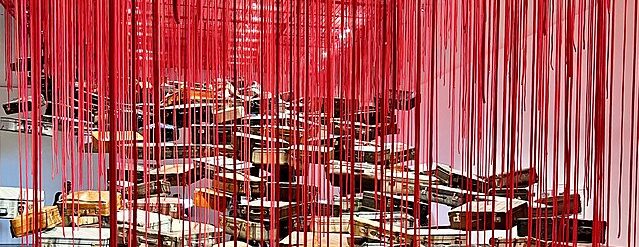Fabrication! Textiles in the Realm of Art
Artists Judith Scott and Chiharu Shiota use textiles and household objects to create emotionally evocative, tangible artworks that portray representations of human connection. Judith Scott creates intricately layered sculptures from yarn, which often do not form a recognisable shape, but a cocoon-like form. Chiharu Shiota is renowned for her large textile instillations, in which she forms intricate webs from yarn, plastic tubes and other mundane objects, which typically occupy the space of an entire room.
As [Scott] does not have access to verbal forms of communication, she expresses herself through her sculptures
Though both artists produce extremely unique, contrasting art, they both use their work as a form of connection and communication with the viewer. This is especially personal for Scott, as she is unable to communicate through speech. Scott was born with Down Syndrome and developed deafness after having scarlet fever as a child. Her deafness was not recognised by those around her until much later in life, which caused people to think that she was uneducable, meaning she was not taught how to efficiently communicate, especially as she was isolated by her family and sent to a school which showed little care for her. Therefore, as she does not have access to verbal forms of communication, she expresses herself through her sculptures. This is particularly achieved through her carefully chosen colour pallets. Her final sculpture, which Scott created very shortly before her death, was composed entirely of black yarn, as she attempted to communicate her pain to her sister. This sculpture allowed Judith’s sister, Joyce, to recognise Judith’s suffering and hold her in her arms during Judith’s final moments.
[Shiota’s] intertwining webs of yarn indicate the complexities of societal relationships and the way in which human relationships are entangled and complicated
While Scott uses her art for personal expression and communication, Shiota’s work represents a more universal form of human communication. Her intertwining webs of yarn indicate the complexities of societal relationships and the way in which human relationships are entangled and complicated. She also displays social commentaries through her art, as she reflects issues of womanhood to her viewers. She has achieved this through the use of red liquid in plastic tubes and yarn, which represent blood, and varying symbols of societal burdens which women face. An example of this is her piece, ‘Dialogue with Absence (2010)’, in which Shiota connects tubes filled with red liquid to a suspended wedding dress, as though blood is streaming out of it. This poignant instillation comments on the restrictive nature of societal expectations placed on women, and how they strip individuality and identity and serve as a universal burden. The use of liquid, in addition to yarn, introduces multiple textures, and encourages the viewer to recognise the intricacies of Shiota’s works.
The textile medium allows both artists to engage their viewers’ senses. This medium creates this sense like no other material could, which is evident in Scott’s work, as she intricately and meticulously layers yarn, often using everyday objects as armatures. The use of mundane objects as structures, which form a framework for her pieces, reflect the extremely personal nature of these sculptures. Furthermore, the many layers which are created by Scott may indicate a sense of concealment, as she completely hides the mundane objects which form the foundations of her sculptures. This may portray her lack of recognition and attention throughout her youth, and perhaps Scott feels as though she is concealed as, before being introduced to art, her thoughts were completely unknown to others.
Yarn is an extremely effective medium in Shiota’s work, as its nature allows for entanglement and complex interwoven patterns
While Scott uses yarn to create layers, Shiota creates webs, which shows the versatility of the use of textiles within art. Yarn is an extremely effective medium in Shiota’s work, as its nature allows for entanglement and complex interwoven patterns. Furthermore, Shiota takes advantage of her material as she displays the tension and complexity of human connection through the creation of tension in her yarn, which adds to the overall intriguing texture of her work. Also, yarn is the ideal medium for Shiota’s work, as it allows her to create empty space within her webs and interweave everyday objects, such as keys and shoes, which indicate the memory of human contact. This reflects the ephemeral, impermanent nature of human connection, as memories easily get lost in the overwhelming tangle of relationships and memory.
While Chiharu Shiota evokes a sense of universal connection, entanglement, and memory, Judith Scott’s sculptures display an extremely intimate insight into her psyche and emotional state. Their use of textile mediums allows for experimentation and freedom in their portrayals of human connection, which engages and immerses the viewer.

Comments